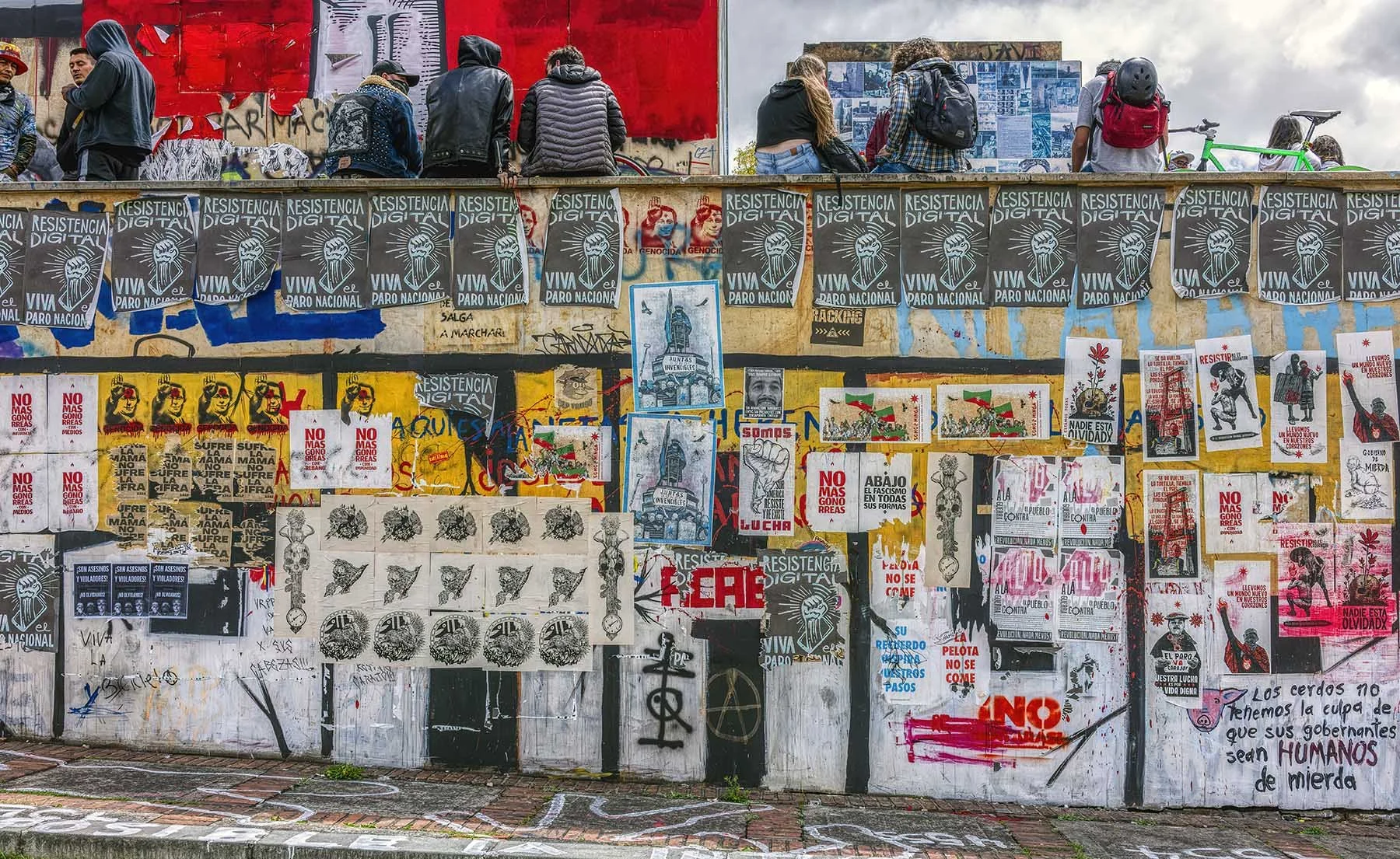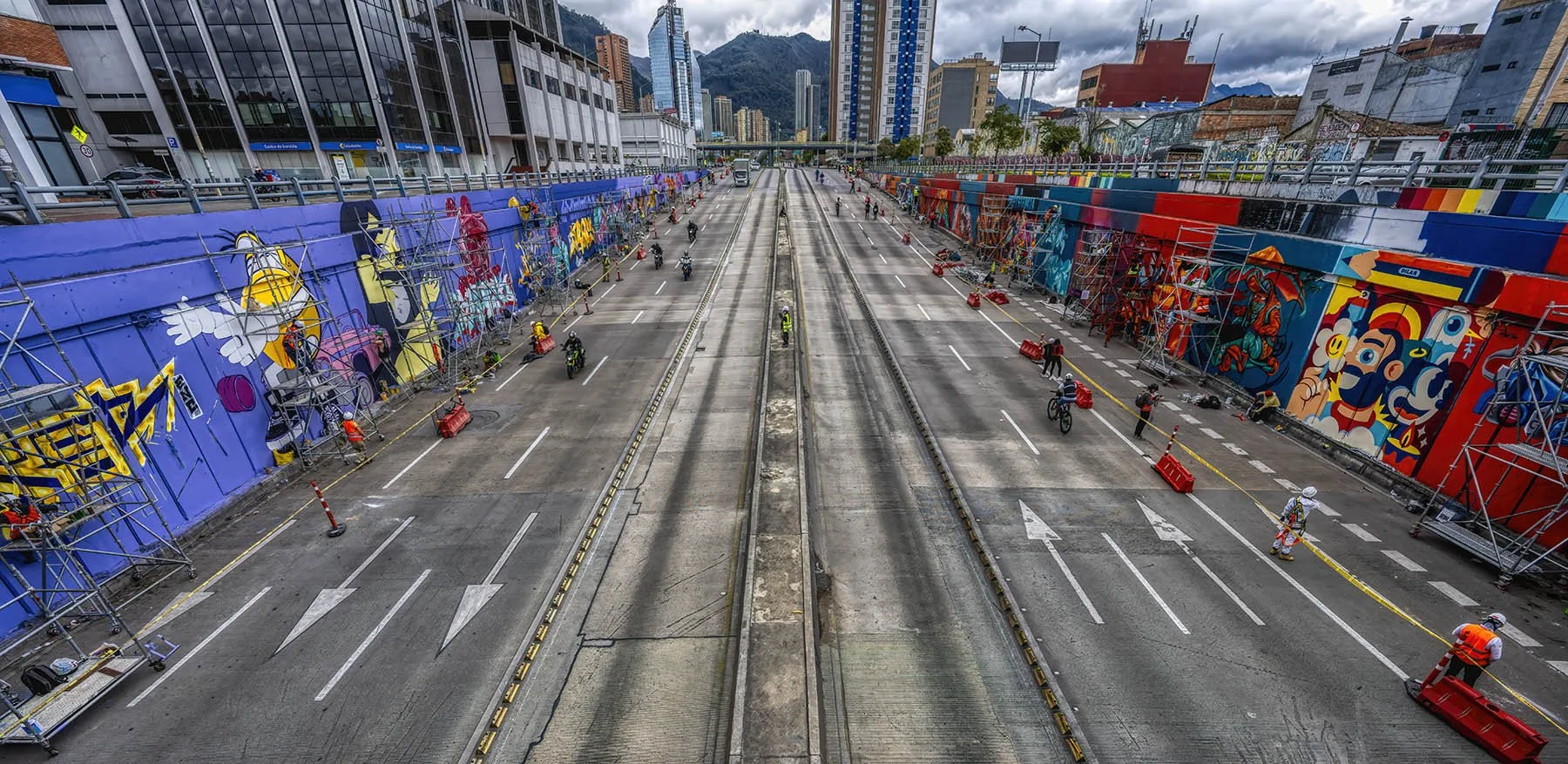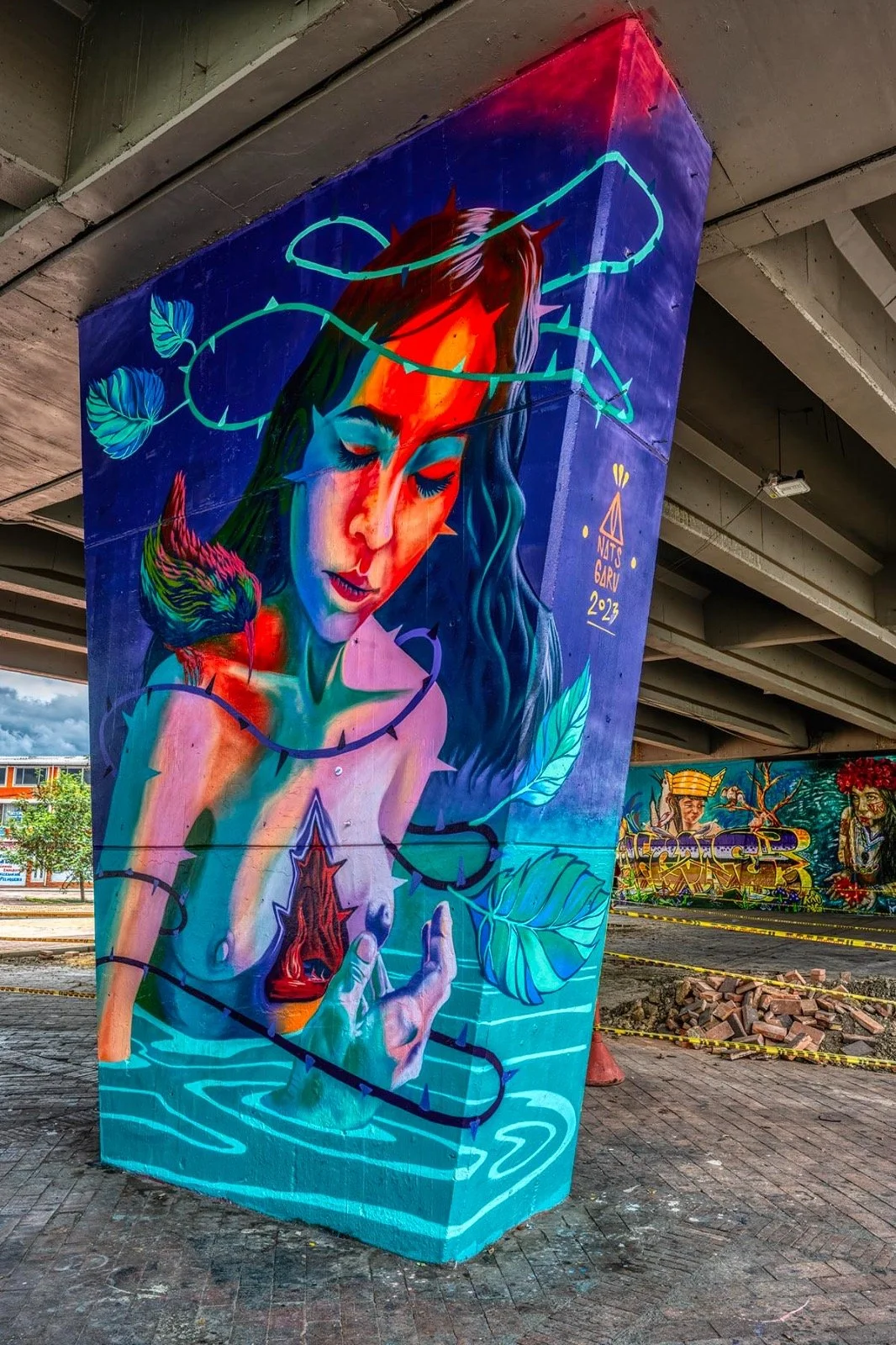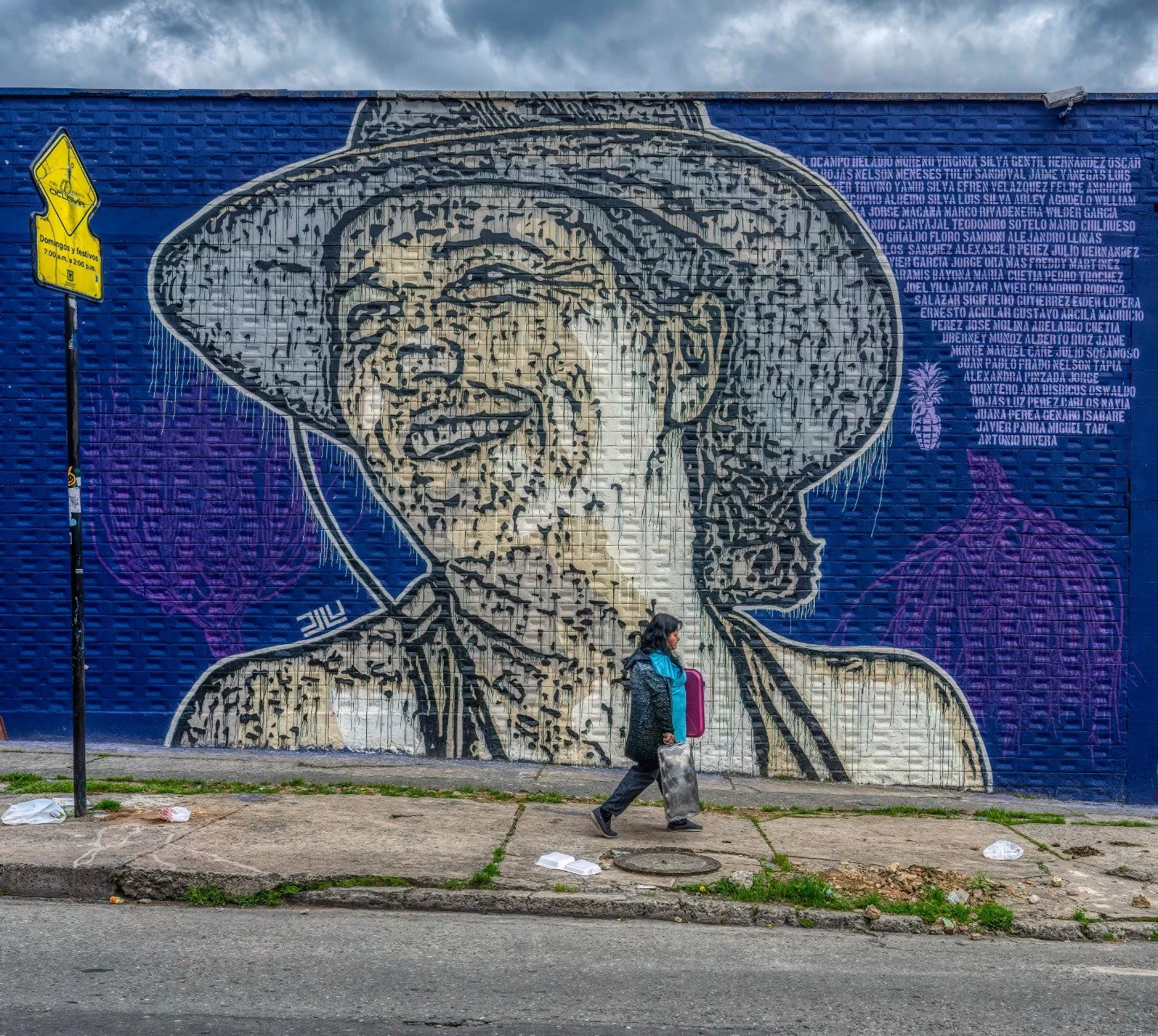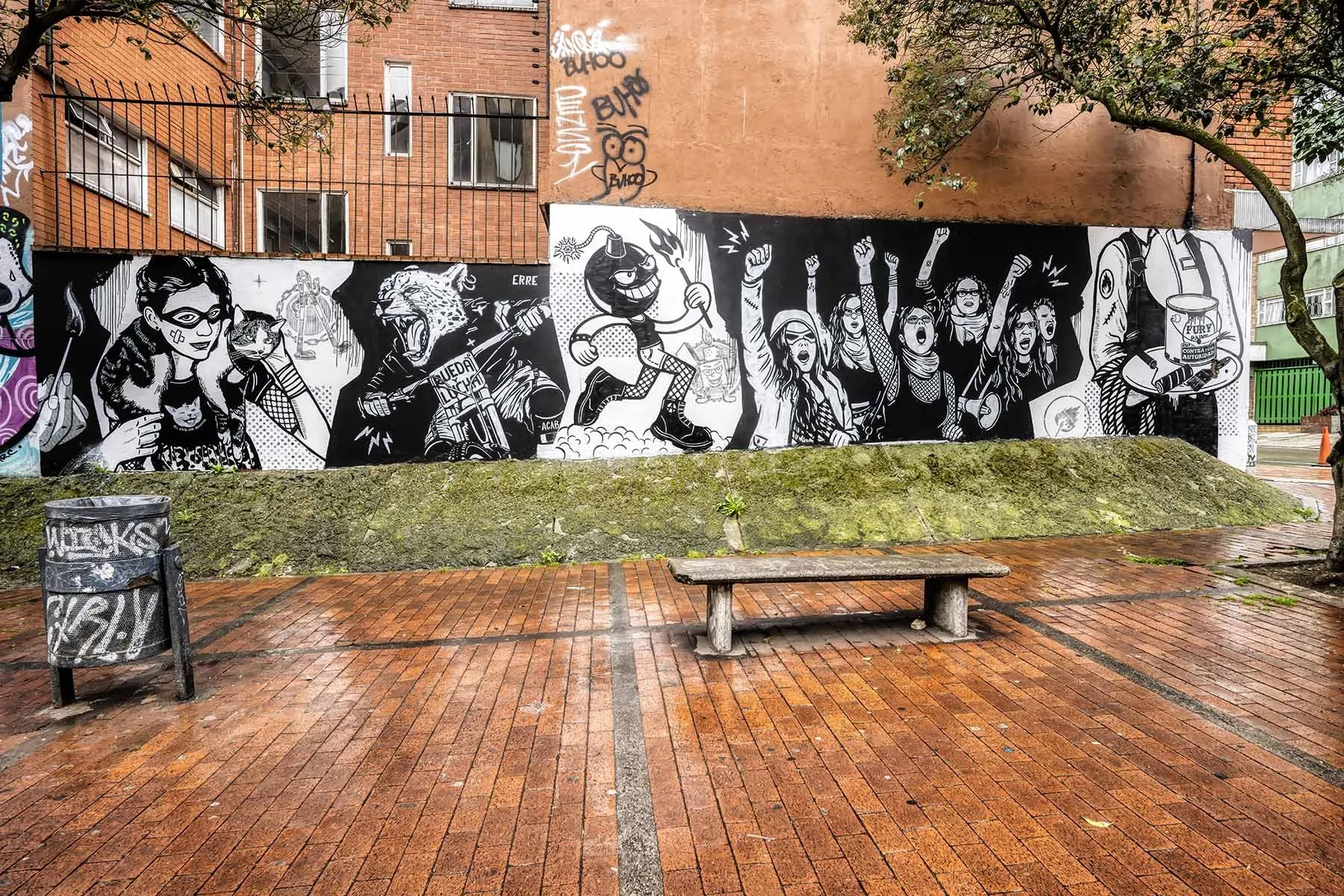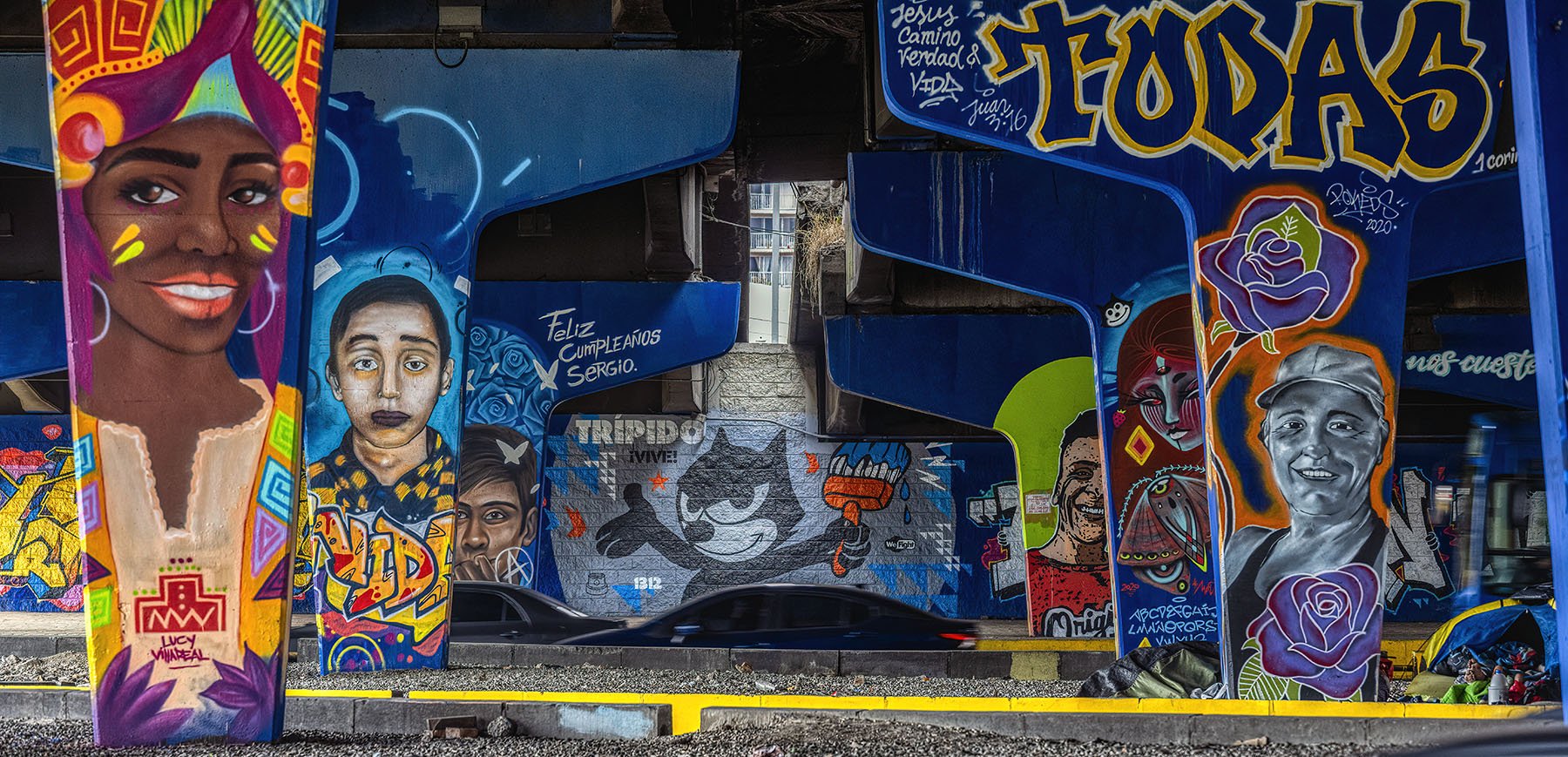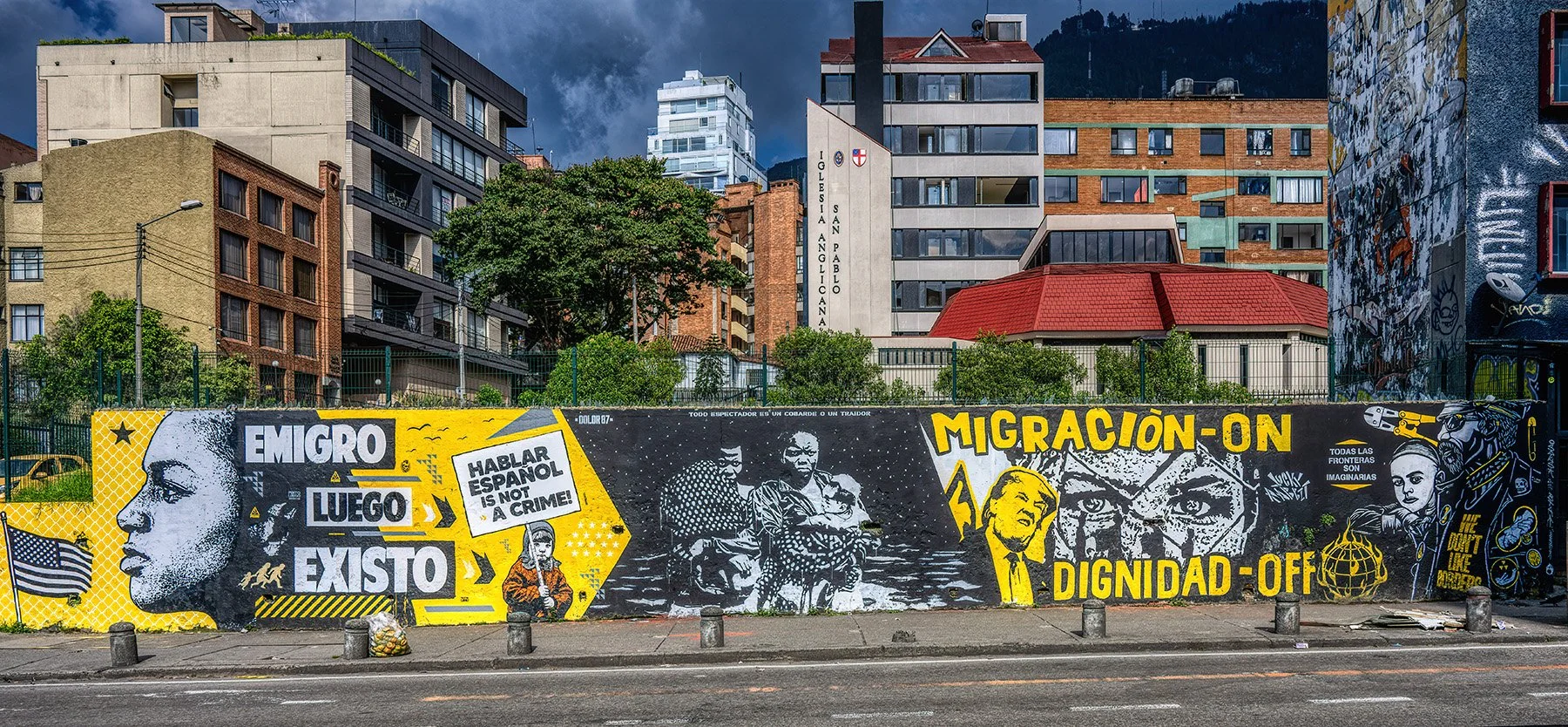ARTE DESDE EL PARO
Curated by Philippa Scholz, Frontline Street Art (FLSA) | Photography by Eric Stone
Exhibition Hosted by Ocio Gallery
Introduction
Four years have passed since the unprecedented 2021 National Strike (El Paro) in Colombia.
This pivotal social movement marked the beginning of a new era in the use and perception of urban art—transforming it into a powerful force for social and political change not only in Bogotá, but resonating across Colombia and beyond.
ARTE DESDE EL PARO, curated by Philippa Scholz, founder of Frontline Street Art (FLSA), presents striking photographs by Eric Stone and is accompanied by an in-depth analysis on the FLSA webpage. This exhibition, hosted at Ocio Gallery in La Macarena, Bogotá, represents years of research and documentation by Scholz, whose academic work on street art during El Paro forms the foundation of this showcase.
Through powerful visual storytelling, the exhibition invites dialogue on the political power and potential of Bogotá's graffiti, street art, and muralism—spotlighting their role in shaping resistance, reclaiming public space, and amplifying voices from the frontlines.
A Note from Philippa, FLSA Founder:
YOUR PERSPECTIVE MATTERS
This exhibition represents countless hours of collaboration with Bogotá's urban art community, who have generously shared their experiences and insights with me since 2021.
As I complete my master's thesis, I'm exploring how both locals and visitors perceive the political significance of Bogotá's urban art. Your thoughts are invaluable to this research.
Please take a moment to share your perspective through my anonymous survey. Your insights will help inform recommendations to artists, researchers, and policymakers on supporting public art creation that strengthens communities.
As thanks, gallery visitors who complete the survey will receive a limited-edition FLSA sticker.
Thank you for contributing to this ongoing dialogue between art, politics, and public space!
El Paro Nacional [2021]
The Cause
El Paro Nacional erupted on April 28, 2021—a monumental nationwide protest initially sparked by a proposed tax reform that would increase the costs of basic goods and services. What began as economic dissent quickly evolved into something far more profound: a collective outcry against a layered crisis of governance.
After years of persecution of social leaders, neglect of struggling students, mounting reports of falsos positivos (civilians falsely presented as guerrilla assassinations), blatant structural inequality and environmental degradation—tens of thousands of Colombians flooded the streets to demand a more just future.
The ProtesT
What started as peaceful demonstrations rapidly escalated. As historic numbers of citizens mobilized, opportunists exploited the police preoccupation to loot and vandalize property, particularly in Cali. The government, seizing an opportunity to demonstrate authority, deployed the Escuadrón Móvil Antidisturbios (ESMAD)—the "Mobile Anti-Disturbances Squadron"—and authorized heightened force.
Protesters exercising their legal rights through marching, chanting, singing, and dancing suddenly found themselves facing lethal weapons and military-style dispersal tactics.
According to human rights organizations, El Paro witnessed widespread abuses—dozens of murders, numerous sexual assaults, and hundreds of instances of illegal force. Social media became essential for citizen documentation, broadcasting real-time footage that countered government-controlled media narratives.
Reports emerged of signal jammers deployed in Cali to disrupt communication among protesters, along with targeted attacks on social media accounts documenting El Paro. Though not definitively confirmed through legal proceedings, tech-rights organizations continue to investigate these troubling claims.
While Cali became the epicentre of violence, abuses occurred nationwide. Yet amid the clear divisions between protesters and the state/elite, the country-wide suffering paradoxically fostered profound unity among demonstrators. What might have been a brief protest continued for weeks—long after the tax reform was abandoned. The combination of state violence with the year-long fear and isolation of the pandemic created a pressure cooker effect that ultimately exploded into expressions of resilience and hope.
The result? Spontaneous community action.
Communal pots serving food to protesters. Free performances. Daily cacerolazos (the banging of pots and pans in solidarity). And art—everywhere.
Art on protest signs. Performance art. But most notably, urban art. Graffiti, street art, and murals blossomed across Colombia in unprecedented ways, forever altering the landscape of urban expression in the country.
Urban Art During El Paro
During El Paro, significant shifts occurred in how street art, graffiti, and murals were created, received, and disseminated. These artistic interventions not only transformed the physical backdrop of the protests but have continued to influence Colombia's urban art scene years later.
Unprecedented Collaboration
While distinctions between graffiti, street art, and murals can be fluid, certain characteristics typically differentiate them. Graffiti—born of hip-hop culture and associated with tags, bombing, and stylized calligraphy—operates largely in the illegal realm. Street art encompasses a broader spectrum of imagery, themes, and techniques created in public spaces both legally and illegally. Murals generally represent commissioned, legal works with formal approval and funding.
Artists may move between these forms, but the subcultures surrounding each maintain distinct values regarding collaboration, public recognition, and commercial success. Traditional graffiti communities, in particular, often resist mainstream integration and cross-genre partnerships.
El Paro, however, catalyzed a remarkable dissolution of these boundaries. Artists from diverse backgrounds and stylistic approaches united to teach techniques and facilitate political expression—creating paste-ups, murals, and text-based works. Moreover, they welcomed non-artists into the creative process, providing tools and guidance for communal art-making. These collaborations fostered solidarity, purpose, and—critically—offered a safer avenue for protest as confrontations at the frontlines grew increasingly violent.
Emergent Aesthetics
The need to accommodate novice participants gave rise to distinctive aesthetic patterns during El Paro. Block lettering proliferated across walls and streets, becoming emblematic of the movement's visual language. The growing accessibility of drone technology enabled massive-scale interventions across avenues and plazas—works designed to be viewed from above, delivering messages with unmistakable clarity when captured and shared.
Social Media Amplification
The technological documentation of street-level art proved transformative. Social media platforms enabled protesters to share images and videos of urban art instantaneously, connecting participants throughout Colombia and inspiring stylistic replication across regions. Beyond national borders, international artists and supporters created works in solidarity, inspired by the images circulating online—extending El Paro's visual resonance globally.
Shifting Public Perception
Perhaps most significantly, El Paro reconfigured how urban art was perceived by previously skeptical or hostile audiences. While Bogotá's relative tolerance for street expression meant less dramatic change in the capital, smaller cities and towns witnessed profound attitudinal shifts. As street art emerged as a tool for community building and inclusive expression, even former critics began participating—painting alongside artists and donating materials to support creative resistance.
Counter-Movements
As urban art gained political potency during El Paro, it inevitably became a target. Both state actors and counter-protesters—predominantly from elite classes less impacted by economic hardship but inconvenienced by the demonstrations—organized to erase these expressions. Nighttime operations to paint over walls or deface artworks became common.
Yet, true to graffiti culture's resilient response to buffing, covered works were swiftly replaced—not by individual artists, but by collective action from the broader protest community. Each erasure only reinforced the importance of visual resistance.
Urban Art Legacy Post-El Paro
While direct causal links between El Paro and subsequent social, political, and economic changes remain complex, the protest undeniably transformed Colombia's urban art landscape. A growing generation of artists cite their participation in El Paro's creative resistance as formative inspiration.
The increasing recognition of Bogotá's vibrant street art scene has attracted substantial investment. Between 2020-2023, Mayor Claudia López allocated 20 billion Colombian pesos toward urban art initiatives, including the "Festival Internacional de Arte Urbano." This festival invited local and international artists to create works along designated "corridors" throughout the city.
This institutional embrace of urban art has elicited mixed responses from the artistic community. While providing employment opportunities, public accessibility, and subcultural recognition, the initiative has also faced criticism for alleged favoritism, tourist-driven motivations, and the potential dilution of political agency. Though artists retained nominal creative freedom, underlying power dynamics and concerns about future opportunities created subtle constraints on explicitly anti-establishment expression.
Nevertheless, examining the evolving urban landscape over the past four years reveals that despite commercialization pressures, political messages continue to flourish throughout Bogotá. Some statements assert their politics explicitly, while others communicate through more nuanced engagement with style, production methods, and cultural references.
The photographs featured in "Arte Desde El Paro," captured by Eric Stone, document this ongoing dialogue between art and politics in Bogotá's streets. Each image addresses distinct political themes, reflecting Colombia's most pressing contemporary issues.
Multiple Artists
Three Marathons Event, 2023
Collaborative urban art intervention
Centro, Avenida El Dorado, Bogotá
Thematic Explorations
Environmental Protection
As the world's second most biodiverse nation after Brazil (and the leader in bird species diversity), Colombia's natural heritage features prominently in Bogotá's urban art. These representations extend beyond mere celebration of ecological wealth—they advocate for environmental protection, honor land defenders, and challenge economic systems that reduce nature to extractable resources.
A critical undercurrent within the artist community questions the "birdification" of Bogotá's street art. While aesthetically appealing, some artists push for more nuanced engagement with Colombia's complex environmental realities. Artist Nats Garu exemplifies this approach, weaving together feminine imagery with socio-environmental concerns like displacement and resource exploitation.
Nats Garu
GUARIDA, 2023
Created during Three Marathons Event
Engativá, Bogotá
Persecution of Social Leaders
Colombia leads the world in murders of social activists—a devastating reality that urban art refuses to let fade from public consciousness. Global Witness reported that in 2023 alone, 79 environmental and land defenders were murdered in Colombia, far exceeding Brazil (25), Mexico and Honduras (18 each).
Such statistics, while shocking, often remain abstract for urban dwellers whose daily lives feel removed from rural struggles. Street art in Bogotá bridges this disconnect, amplifying the voices of social leaders and commemorating those killed for their activism.
DJLU, internationally recognized for his political street art, has spent over 20 years developing distinctive pictographs and stencil work that confronts systems of oppression while elevating marginalized voices. His work exemplifies how urban art translates distant struggles into visible, accessible expressions of solidarity.
DJ LU / Juegasiempre
Tribute to Assassinated Social Leaders, 2022
Municipal art project
Las Cruces, Bogotá
Feminism
Patriarchal structures permeate Colombia's social fabric, as they do globally. Women and gender-diverse individuals—including transgender and non-binary persons—continue fighting for equality and safety. In 2023, 630 femicides were reported in Colombia—nearly two women killed each day.
Street art and murals serve as tools for protest, awareness-raising, and celebration of women and gender-diverse identities. Yet the urban art community itself reflects broader societal inequities. Women artists report receiving fewer economic opportunities, having their talents undervalued compared to male counterparts, or being mistaken for "assistants." More troublingly, instances of physical harassment and violence persist within the scene—underscoring the continued need for structural change within artistic communities themselves.
Erre
Untitled, 2023
Chapinero, Bogotá
Youth Empowerment
Prior to El Paro 2021, student movements had already gained momentum across Colombia, notably in 2018. These mobilizations signaled a generational shift in political consciousness. Today's youth, having not experienced the height of narco-trafficking violence in the late 1980s-90s, and often raised in urban areas relatively insulated from rural conflicts, demonstrate a distinctive fearlessness in claiming their rights.
This is not to discount the progress hard-won by previous generations, nor to suggest complete safety for contemporary activists. However, digital connectivity has transformed organizing capabilities, allowing young people to exchange ideas and coordinate action with unprecedented efficiency. Bogotá's streets now reflect this determination, as Colombia's youth visualize and demand a more just future.
Unknown
Youth Building Territories Without Fear, 2025
Bosa Centro, Bogotá
Artistic Memory
Street art and graffiti have long served as vehicles for communal memory—particularly for honoring victims of state violence. The murder of Diego Felipe Becerra (known by his graffiti name "Tripido") by police on August 19, 2011, continues to be commemorated throughout Bogotá. Artists across the city reproduce his iconic cat tag, simultaneously preserving his memory and affirming solidarity within the urban art community.
Tripido's parents, Gustavo Trejos and Liliana Lizarazo, have become vital advocates for artists' rights and against police brutality. Their efforts, alongside those of allies like lawyer Camilo Fidel López (director of Vertigo Graffiti), helped secure Law 75, which decriminalized the production of graffiti and street art—providing legal protection for those who continue to face persecution for their work.
Toxicómano and Collaborators
Mural of State Victims, 2021
Commissioned by Tripido Foundation
Engativá, Avenida Boyacá, Bogotá
Global Solidarity
While Bogotá's street art often addresses distinctly Colombian concerns, it also engages with global politics. For example, since 2023, pro-Palestinian expressions have notably increased, yet the city's walls respond to virtually all major international developments. This reflects our interconnected world, where political decisions made continents away carry profound local implications for economic stability and political conditions.
The mural featured in this exhibition exemplifies this global awareness. It responded to the executive order on 1 March, 2025, declaring English the official language of the United States—a policy threatening to disenfranchise the 13% of America's population who primarily speak Spanish. The order potentially eliminates language assistance in essential services like healthcare, with ripple effects for Colombian immigrants and their families.
Toxicómano Callejero, Dolor 87, Lucky Rabbit and Signar
Emigro Luego Existo / I Emigrate Therefore I Am, 2025
Chapinero, Bogotá
Direct Political Intervention
Beyond subtle political commentary, urban art in Bogotá continues to deliver explicit challenges to power. This follows a long tradition of wall-based communication in Colombia, dating back to guerrilla groups' use of tags and slogans in both rural and urban areas.
Contemporary messages commonly denounce specific politicians or demand justice for state-perpetrated violations. The number "6402" appears frequently across Colombia, referencing victims of "false positives"—civilians murdered by state forces and falsely presented as guerrilla casualties to inflate kill statistics.
In early 2025, the Jurisdicción Especial para la Paz (JEP, or Special Jurisdiction for Peace) announced that remains had been found in La Escombrera landfill in Medellín—confirming what families had alleged for decades.
Collective Action
Las Cuchas Tienen Razón, 2025
Community-led protest intervention
Chapinero, Bogotá
This site, long suspected to contain up to 300 victims from the early 2000s, had been the focus of families from Comuna 13 who persistently demanded excavation despite being dismissed and silenced by authorities. After twenty years of struggle, these families finally received validation that their loved ones had indeed been buried where they claimed.
"Las Cuchas Tienen Razón" ("The Mothers Were Right") first appeared as a mural in Medellín honoring these persistent mothers. The message rapidly spread across Colombia in identical colors and block lettering, expressing nationwide solidarity and outrage. Through social media, the phrase transcended borders, with murals appearing internationally in cities like Berlin and London—demonstrating how urban art transforms local struggles into global consciousness.
This exhibition is curated by Philippa Scholz, founder of Frontline Street Art, in collaboration with photographer Eric Stone and hosted at Ocio Gallery. The research, organization, and conceptualization of this exhibition represent Scholz's ongoing academic work examining the political significance of street art during and after El Paro. For more information or feedback about this research and future projects, email @frontlinestreetart@gmail.com
Visit the Exhibition at OCIO Gallery:
Cra. 5 #26b - 26, Bogotá
Hours
Monday–Sunday, 11am–5pm
Phone
321 2605144





